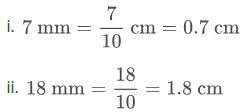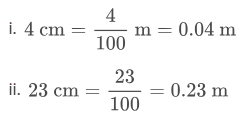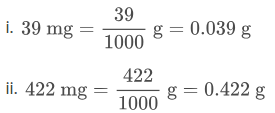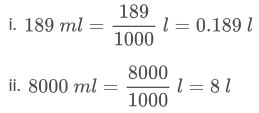Class 6: Mathematics
-
Chapter 1: Knowing Our Numbers5 Topics|2 Quizzes
-
Session 1: International Number System and Indian Number System - Definition, Chart, Interactives and Examples
-
Session 2: Comparing and Ordering Numbers - Steps and Examples
-
Session 3: Estimation of Numbers (Rounding Off Method) - Rules, Steps and Examples
-
Session 4: Roman Numerals - Definition, Rules, Chart, Conversion and Examples
-
NCERT Flip Book (Chapter 1: Knowing Our Numbers)
-
Session 1: International Number System and Indian Number System - Definition, Chart, Interactives and Examples
-
Chapter 2: Whole Numbers5 Topics
-
Session 1: What are Whole Numbers? - Definition, Symbol, Comparison and Examples
-
Session 2: Addition and Subtraction of Whole Numbers - Properties and Examples
-
Session 3: Multiplication and Division of Whole Numbers - Division Algorithm, Properties and Examples
-
Session 4: Patterns in Whole Numbers - Definition, Types and Examples
-
NCERT Flip Book (Chapter 2: Whole Numbers)
-
Session 1: What are Whole Numbers? - Definition, Symbol, Comparison and Examples
-
Chapter 3: Playing With Numbers8 Topics
-
Session 1: What is a Factor? - Properties, Methods, Interactives and Examples
-
Session 2: What is a Multiple? - Definition, Properties, Interactives and Examples
-
Session 3: Prime Numbers and Composite Numbers - Sieve of Eratosthenes, Definition, List, Facts and Examples
-
Session 4: Prime Factorisation - Definition, Methods, Steps and Examples
-
Session 5: Divisibility Rules for 2, 3, 4, 5, 6, 8, 9, 10 and 11 - Properties, Chart and Examples
-
Session 6: Highest Common Factor (H.C.F.) - Definition, Methods, Steps, Interactives and Examples
-
Session 7: Lowest Common Multiple (L.C.M.) - Definition, Methods, Steps, Interactives and Examples
-
NCERT Flip Book (Chapter 3: Playing With Numbers)
-
Session 1: What is a Factor? - Properties, Methods, Interactives and Examples
-
Chapter 4: Integers5 Topics
-
Session 1: What are Integers? - Definition, Symbol, Number line, Absolute Value and Examples
-
Session 2: Comparing and Ordering Integers - Rules and Examples
-
Session 3: Addition of Integers - Steps, Rules, Number Line, Interactives and Examples
-
Session 4: Subtraction of Integers - Steps, Rules, Properties, Number Line, Interactives and Examples
-
NCERT Flip Book (Chapter 4: Integers)
-
Session 1: What are Integers? - Definition, Symbol, Number line, Absolute Value and Examples
-
Chapter 5: Fractions6 Topics
-
Session 1: What are Fractions? - Definition, Representation, Number line, Interactives and Examples
-
Session 2: Types of Fractions - Definition, Interactives and Examples
-
Session 3: Comparing and Ordering Fractions - Methods, Interactives and Examples
-
Session 4: Adding Fractions (Like and Unlike Denominators) - Steps, Interactives and Examples
-
Session 5: Subtracting Fractions - (Like and Unlike Denominators) - Steps, Interactives and Examples
-
NCERT Flip Book (Chapter 5: Fractions)
-
Session 1: What are Fractions? - Definition, Representation, Number line, Interactives and Examples
-
Chapter 6: Decimals11 Topics
-
Session 1: What are Decimals? - Definition, Place Value Chart, Expansion, Types, Conversion and Interactives
-
Session 2: Decimal Fraction - Definition, Types, Conversion, Steps, Interactive and Examples
-
Session 3: Comparing Decimals - Steps, Interactive and Examples
-
Session 4: Uses of Decimal Notation - Conversion Chart and Examples
-
Session 5: Adding Decimals - Steps, Interactive and Examples
-
Session 6: Subtracting Decimals - Steps, Interactive and Examples
-
Session 7: Length Conversion - Metric Units and Customary Units
-
Session 8: Mass (Weight) Conversion - Metric Units and Customary Units
-
Session 9: Capacity Conversion - Metric Units and Customary Units
-
Session 10: Temperature Conversion - Metric Units and Customary Units
-
NCERT Flip Book (Chapter 6: Decimals)
-
Session 1: What are Decimals? - Definition, Place Value Chart, Expansion, Types, Conversion and Interactives
-
Chapter 7: Algebra3 Topics
-
Chapter 8: Ratio, Proportion and Unitary Method3 Topics
-
Chapter 9: Understanding Elementary Shapes2 Topics
-
Chapter 10: Basic Geometrical Ideas7 Topics
-
Session 1: What is Geometry? - Points, Lines, Planes and Solids
-
Session 2: Angles - Definition, Types, Interactives and Examples
-
Session 3: Polygons and Curves - Definition, Types, Interactives and Examples
-
Session 4: Triangles - Definition, Types, Interactives and Examples
-
Session 5: Quadrilaterals - Definition, Types, Properties, Interactives and Examples
-
Session 6: Circles - Definition, Formulae, Interactives and Examples
-
Session 7: What are Parallel Lines? - Transversal, Properties, Angles, Interactives and Examples
-
Session 1: What is Geometry? - Points, Lines, Planes and Solids
-
Chapter 11: Mensuration8 Topics
-
Session 1: Perimeter of Rectangle - Formula, Definition, Interactive and Examples
-
Session 2: Perimeter of Square - Formula, Definition, Interactive and Examples
-
Session 3: Perimeter of Triangle - Formula, Definition, Interactives and Examples
-
Session 4: Area of Rectangle - Formula, Definition, Interactive and Examples
-
Session 5: Area of Square - Formula, Definition, Interactives and Examples
-
Session 6: Area of Triangle - Formula, Definition, Interactives and Examples
-
Session 7: Area of Composite Shapes - Definition, Formula, Interactives and Examples
-
Session 8: Area of Irregular Shapes Using Squared Paper - Definition, Interactives and Examples
-
Session 1: Perimeter of Rectangle - Formula, Definition, Interactive and Examples
-
Chapter 12: Symmetry2 Topics
-
Chapter 13: Data Handling3 Topics
-
Chapter 14: Practical Geometry5 Topics
-
Session 1: Construction of Line Segments - Methods, Steps and Interactives
-
Session 2: Construction of Perpendicular Lines (Perpendicular Bisector) - Steps and Interactives
-
Session 3: Construction of Circles - Steps, Interactives and Examples
-
Session 4: Construction of Angles - Steps and Interactives
-
Session 5: Construction of Some Standard Angles (30°, 45°, 60°, 90°, 120° and 135°) - Steps and Examples
-
Session 1: Construction of Line Segments - Methods, Steps and Interactives
-
NCERT AND EXEMPLAR
Number System1 Topic -
Geometry1 Topic
-
Integers1 Topic
-
Fractions & Decimals1 Topic
-
Data Handling1 Topic
-
Mensuration1 Topic
-
Algebra1 Topic
-
Ratio & Proportion1 Topic
-
Symmetry & Practical Geometry1 Topic
Revolutionary SSC Bot: Unleashing Unmatched Efficiency and Precision
The SSC Bot is an advanced artificial intelligence-powered assistant designed to serve as a comprehensive guide for customers. It utilizes cutting-edge AI technology and natural language processing capabilities to understand and respond to customer queries effectively. With personalized assistance, 24/7 availability, and multilingual support, the SSC Bot ensures a seamless and efficient interaction for customers. It also possesses an extensive knowledge base, assists in troubleshooting and issue resolution, and seamlessly integrates with various platforms.
₹100.00Original price was: ₹100.00.₹49.00Current price is: ₹49.00.
Session 4: Uses of Decimal Notation – Conversion Chart and Examples
Admin 17/11/2024
Decimals have some broad and surprising applications in our everyday life. It is primarily used when precision is required, like finding out the exact weight on a scale. You might have seen decimals in a thermometer reading as well. This section deals with the applications of decimals in our day to day lives.
Money
One of the most common applications of decimals is for money. One rupee is made up of hundred paise. Often we also have to convert rupees into paise while shopping, to calculate the amount of the final product.
It takes 100 paise to make one rupee or one whole. One paisa is one out of a hundred.
How can we write 5 paise as a decimal? To do this, we need to think about 5 out of 100. We can say that 5 paise is 5 hundredths of a rupee since there are 100 paise in one rupee.
| Conversion between Paise and Rupee |
| 100 paise = ₹ 1 So, 1 p=₹\(\frac{1}{100}\)=₹0.01 |
Examples:
i. 9 p = 9 hundredths of a rupee₹=\(\frac{9}{100}\)×₹1=₹0.09
ii. 17 p = 17 hundredths of a rupee=\(\frac{17}{100}\)×₹1=₹0.17
iii. 25 p = 25 hundredths of a rupee=₹0.25
iv. 6 rupees 37 paise=₹6+₹0.37=₹6.37
v. 392 rupees 6 paise=₹392+₹0.06=₹392.06
Decimal metric system
By the 18th century, dozens of different units of measurement were commonly used throughout the world. Length, for example, could be measured in feet, inches, miles, spans, cubits, hands, and more. The lack of common standards led to confusion and significant inefficiencies in trade between countries. At the end of the century, the French government devised a system of measurement that could be used throughout the world. This system is known as the metric system.
The decimal metric system is a system of units in which the multiples and sub-multiples of the unit of measurement are interrelated by multiples or sub-multiples of 10.
Measurements of Length: Conversion Chart
The base unit of length is the metre. However, there are other units:
| Conversion between mm and cm |
| 10 mm=1 cm So, 1 mm=\(\frac{1}{10}\)cm=0.1 cm |
Examples:

| Conversion between cm and m |
| 100 cm=1 m So, 1 cm=\(\frac{1}{100}\) m=0.01 m |
Examples:

| Conversion between m and km |
| 1000 m=1 km So, 1 m=\(\frac{1}{1000}\) km=0.001 km |
Examples:

Measurements of Weight: Conversion Chart
The base unit of weight is the gram. However, there are other units:
| Conversion between mg and g |
| 1000 mg=1 g So, 1 mg=\(\frac{1}{1000}\) g=0.001 g |
Examples:

| Conversion between g and kg |
| 1000 g=1 kgSo, 1 g=\(\frac{1}{1000}\) kg=0.001 kg |
Examples:

Measurements of Capacity: Conversion Chart
The base unit of capacity is the litre. However, there are other units:
| Conversion between mL and L |
| 1000 ml=1 l So, 1 ml=\(\frac{1}{1000}\)l=0.001 l |
Examples:

| Conversion between L and kL |
| 1000 l=1 kl So, 1 l=\(\frac{1}{1000}\) kl=0.001 kl |
Examples:

Notice that the relationship between the units of measurement is all based on powers of 10. This is because the metric system is based on powers of 10, just like our number system. To move between different lengths, weights, and capacity units, all we need to do is move the decimal point.
- Any time we go from a smaller unit of measure to a larger unit of measure we will need to divide or move the decimal point to the left.
- Any time we are going from a larger unit of measure to a smaller unit of measure we will need to multiply or move the decimal point to the right.



